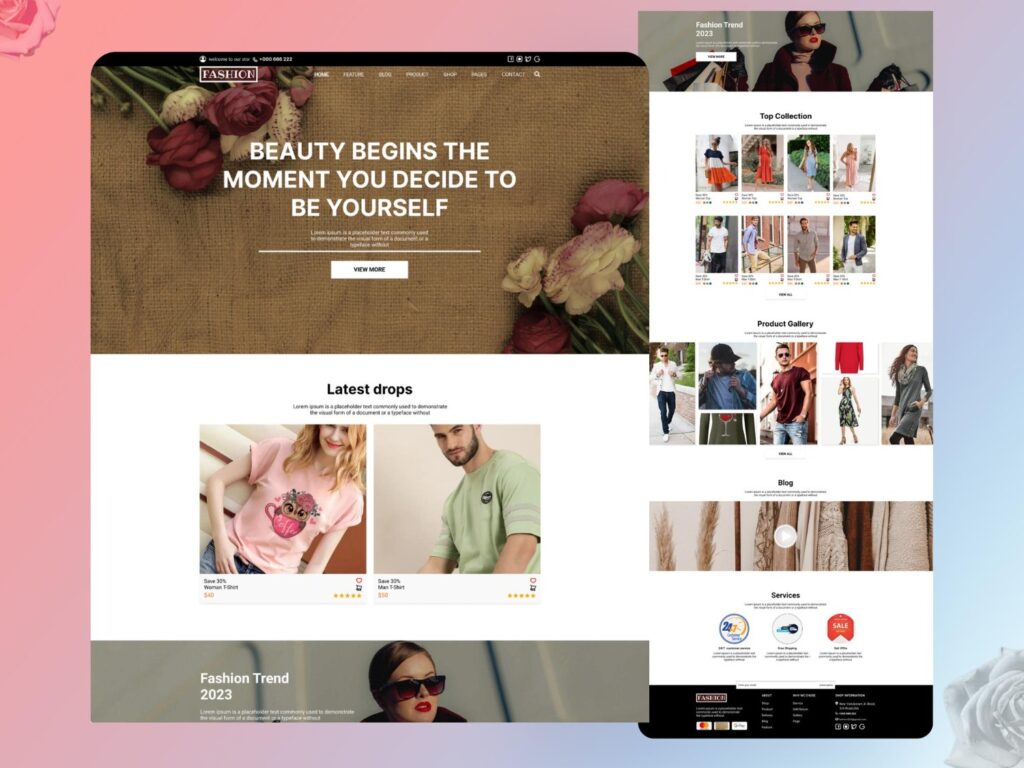
From LEGO to Layout: Building the Most Creative Web Designs Step by Step
Gearing Up for a Creative Odyssey
It was a quiet Tuesday morning when the idea hit me. There I was, picking up stray LEGO pieces scattered across the living room floor, attempting to sidestep the notorious ninja-level pain of stepping on one. As I assembled the plastic bricks into yet another derivative of the Millennium Falcon, it struck me: designing a website is similar to building with LEGO. Both require imagination, precision, and an uncanny ability to navigate unexpected challenges. So, inspired by the colorful chaos at my feet and the ever-evolving digital landscape, I decided to delve deep into the world of web design, specifically how one can transform a basic concept into a digital masterpiece.
As a passionate contributor at Above Bits, nestled comfortably in the vibrant city of Charlotte, North Carolina, I’ve witnessed firsthand how the web design scene is bursting with creativity and innovation. Our city is not just about NASCAR, soaring skyscrapers, or an overwhelming allegiance to the Carolina Panthers. It’s also a tech hub, drawing web designer experts from far and wide. In this article, I aim to take you on a journey from LEGO blocks to digital layouts, exploring the intricacies and nuances of web design. We’ll cover everything from the blocks of website creation to the surprising parallels with global events, weaving in anecdotes that tickle your funny bone and sharing the upsides and pitfalls of some tools you wouldn’t believe.
The First Brick: Understanding the Fundamentals
Just like that initial LEGO brick that anchors your model, the cornerstone of effective web design is knowledge. You need a solid understanding of the fundamentals before you can craft something worthy of sharing your morning cappuccino selfie.
- The Beauty of Blocks: Initially, websites were simple static pages. Over the years, they’ve evolved into complex, interactive experiences. Today, web design is akin to constructing with modular bricks—each piece, or UI component, can be architected to fit perfectly. This evolution is mirrored in content management systems like WordPress, which powers approximately 43% of all websites as of 2023. WordPress, much like LEGO, offers endless possibilities without the need to start from scratch every time.
- WYSIWYG: The Missing Puzzle Piece. For those who freeze at the mere mention of HTML or CSS, WYSIWYG (What You See Is What You Get) editors are akin to finding that elusive interlocking piece amidst a tumble of bricks. Platforms like Wix and Squarespace offer intuitive design interfaces, allowing creative minds without coding skills to construct stunning websites by dragging, dropping, and tweaking until perfection—or something close to it—is achieved. Yet, much like piecing together LEGO, these editors can sometimes limit your flexibility, restricting your ability to add unique twists and turns.
- Flexibility vs. Functionality: A recurring challenge in web design is balancing creativity (like trying to build a flying car out of LEGO) with functionality (ensuring it doesn’t crumble into multicolored dust at the first push). As we embrace ‘mobile-first’ approaches—given that nearly 54.8% of global website traffic is via mobile devices—designing responsive and user-friendly sites across multiple devices becomes increasingly crucial.
- The Grumpy Uncle HTML and the Cool Cousin CSS: These two trusty and sometimes volatile entities are the yin and yang of web design. HTML, the underdog that’s been around since the early ’90s, lays the foundation, acting much like the instruction manual of a LEGO set. Then there’s CSS with its aesthetic flair, bringing vivid colors and animations akin to LEGO’s snazzy new range of digital-enhanced sets. Yet, beware: like family gatherings where tensions rise, these two can clash—Chrome may display your masterpiece perfectly, while Safari seems to have stepped on one too many LEGO bricks.
Digital Blueprints: Aligning Creativity with User Intent
Stepping back from the screen—or LEGO assembly—for a clutch power-recharge moment brings clarity that creativity is useless if it doesn’t align with user needs. At Above Bits—our web design company in Charlotte—we believe that this alignment is the secret sauce that turns a ho-hum website into a buzz-worthy digital destination, much like how a brick changes the entire LEGO structure from simply standing into eye-catching.

User Experience: The Master Builder Approach
Crafting a website that resonates with users involves knowledge peppered with a dash of psychology and a sprinkle of empathy. It’s like inviting your users into your world and making sure they don’t stub their pinky toes on unexpected design elements or convoluted navigation paths. As a web designer in Charlotte, I find that viewing the layout through the lens of user intent is instinctive. Here, it’s not just Southern hospitality that counts, but digital hospitality, too.
- Wireframes: The Blueprint of the Web World. Web designers start with wireframes just as an architect sketches a building before laying down bricks. These skeletal layouts resemble basic LEGO structures constructed during brainstorming—void of color but clear on the structure. Ensuring your web design sticks to the wireframe strategy is crucial, providing a guide to the chaos without eliminating creativity. This means envisioning where your buttons will click, images will pop, and text will flow, aligned like a perfectly constructed LEGO model.
- User Testing: The Litmus Test of Creation. Building on wireframes, user testing is the internal critics’ panel, offering insights that might save your digital rear. According to a recent survey, 88% of users are less likely to return to a site after a bad experience. Gathering genuinely user-centric feedback or risk turning users away faster than the tumultuous stock value fluctuations epitomizing the global economic climate is imperative.
- Emotion in Motion: CSS Animations and User Engagement. Adding flair with CSS animations might seem like accessorizing a LEGO mini-figure, but it strongly influences user engagement. Carefully timed transitions and animations guide users seamlessly from one block of information to the next, like an intricate LEGO roller coaster that assures a smooth ride rather than a bumpy journey. However, excessive ornamentation might result in a cluttered user interface, sending users spiraling away from your web design.
FOR MORE INFORMATION CLICK HERE : desert safari tours dubai
Layer by Layer: Crafting the Aesthetic Palette
While every LEGO set has a guide for each model variant, true innovation emerges when builders venture beyond those boundaries. Similarly, web design thrives on aesthetic creativity and experimentation, moving beyond templates into engaging, brand-centric narratives. Our journey in Charlotte’s buzzing digital realm has shown us that understanding and applying design principles is key to standing out in the virtual crowd.
Branding: From Brick Patterns to Brand Patterns
In web design, creating a coherent brand voice is equivalent to choosing a theme for your LEGO creation. The colors, typography, and imagery you choose weave a narrative, much like deciding that your brick-built Indiana Jones wouldn’t wear a fluorescent orange fedora.
- Color Psychology: Painting with Purpose. In the same way, a specific color brick might inspire the direction of your LEGO masterpiece; colors on a website evoke emotions and sway perceptions. Studies highlight that color improves brand recognition by up to 80%, emphasizing its critical role in web design. Finding the perfect palette involves a balance between brand representation and accessibility, ensuring vibrancy doesn’t become an eyesore.
- Typography: The New Architect’s Calligraphy. Just as a LEGO builder chooses pieces that fit together seamlessly, typographers in web design curate fonts that create harmony across the page. With typography accounting for around 95% of web content, according to Oliver Reichenstein, it becomes apparent that this isn’t a decision to make lightly. What’s the point of a slick web design if users skip past text rendered in Comic Sans?
- Visual Hierarchy: Guiding Eyes Step by Step. Imagine assigning importance lanes on a LEGO racetrack, where design elements vie for prominence. Visual hierarchy uses the principles of size, color, contrast, and alignment to smoothly guide user attention from one section of the website to the next, like following a marked path in a LEGO labyrinth. A consistent layout ensures users don’t get lost.
Coding Cleverly: Transforming Creativity into Functionality
Now, as a seasoned web design agency in Charlotte, one of the perennial questions we encounter is how to inject flair without losing functionality, and discovering the sweet spot between innovative design and smooth performance hinges on using the right technologies and methodologies.
Back-End and Front-End Development: The Unsung Heroes
Whereas front-end development focuses on the visible LEGO masterpiece, back-end development, albeit behind the curtain, powers the magic that leads bricks to move seamlessly.
- JavaScript: The Master Brick. JavaScript is like that versatile LEGO piece, adaptable to connect multiple elements with ease. As a language enabling dynamic interaction, JavaScript powers 95% of the world’s websites, making it as integral as that flat 2×4 piece that just seems to fit everywhere. However, beware of overloading with too many scripts; performance issues could set in post-launch.
- Frameworks vs. Libraries: The Assembly Guidebook Debate. When coding, choosing between a framework (like choosing a LEGO theme: Space vs. City) and libraries (choosing individual LEGO pieces) can be a dilemma. ReactJS and Vue.js are heralded for their versatility and speed; however, their modularity might overwhelm developers craving a straightforward blueprint—reminiscent of how rookie builders tremble at the prospect of a 5000-piece complex LEGO set.
- Responsive Design: Fluidity on Every Brick. In today’s digital ecosystem, ensuring a site looks spectacular across devices isn’t just nice to have—it’s imperative. This necessitates a mobile-responsive design strategy that mirrors a LEGO set’s adaptability, effortlessly switching between spaceship and boat configurations. Yet, the nuances of varying screen sizes present constant challenges, like building with uniquely shaped LEGO pieces that don’t always fit snugly.
Analytics and Optimization: Fine-Tuning the Digital Experience
Designing a phenomenal website is only part of the battle. Optimization and analytics help refine the user experience post-launch, ensuring your digital LEGO world remains engaging and efficient.
Peering into User Behavior: The New Science
Just like a LEGO cityscape never slumbers, website analytics uncover illuminating insights via user journeys and interactions. They are the guides that steer future iterations and improvements.
- Google Analytics: The Ultimate Control Tower. Using Google Analytics, you gain the same control over web traffic as city planners have over bustling pedestrian throngs, examining metrics like bounce rate, which averages 43% across industries. Without proper analysis, you’ll build a deserted webren plain as barren as a LEGO diorama missing its mini-figures.
- A/B Testing: The Split Brick Phenomenon. A/B testing can quickly show how a subtle change unlocks an uptick in engagement—akin to swapping out a gray LEGO piece for a glossy translucent one. However, too much experimentation can derail coherent design schemes, resulting in tangled mass web pages.
- SEO: The New Age Digital Brick Finder. Ensuring your website ranks on search engines is pretty close to fishing your final piece from a sea of LEGO. This involves techniques like keyword incorporation (like “web design Charlotte,” “Charlotte web design company”) that blend accessibility seamlessly into engaging content, inevitably attracting more visitors. Yet, overstuff your page with keywords, and the digital LEGO tower comes crashing down through penalization.
The Quest for Connectivity: Bridging the Digital Divide
Design, code, and strategy create a harmonious blend that is the connective tissue of successful web design. However, connection extends beyond design aesthetics and technical finesse—it’s about making an empathetic link with your audience.

Storytelling in Web Design: Crafting Narratives Brick by Brick
Today’s consumer cares about stories, whether conveyed through a LEGO stop-motion film or website scrolling. In 2023, injecting your brand story into web design will mark your digital presence and forge connections that transcend the online medium.
- User Persona: Building the Figurine. Much like crafting the personality of a LEGO mini-figure depicting your childhood hero, understanding user personas helps tailor the user experience. This means piecing together demographics, preferences, and pain points to guide design and content choices effectively.
- Content Strategy: Block by Block. Crafting compelling content is crucial to pique interest and retain visitors. According to HubSpot, companies that publish detailed blogs (over 3,000 words) secure 3.5 times more traffic, showcasing the importance of concise, value-packed narratives building the site story reminiscent of piecing together a multi-layered LEGO puzzle.
- Community: A Digital LEGO Enthusiasts Group. Brands that foster a sense of community translate their digital presence into tangible involvement. Community engagement breathes life into an otherwise static site and creates advocates who magnify brand perception—a virtual LEGO club multiplying creative builds exponentially.
Through the vision and expertise of Above Bits in Charlotte, the dynamic realm of web design achieves a seamless interplay between creativity and technology. Above Bits brings innovation from the heart of North Carolina to take design concepts from humble beginnings, as scattered and colorful as LEGO bricks, to cohesive digital experiences, never ceasing to explore the web world’s artistic horizons and technical depth.
Ready to Build Your Digital Masterpiece?
Discover how Above Bits, your go-to web design experts in Charlotte, can transform your vision into a captivating online presence. Whether you’re reimagining outdated layouts or launching a brand new project, our team guides you every step of the way. Visit us today, and let’s construct an extraordinary digital world together, one innovative idea at a time. Let’s create something incredible because, in web design, the possibilities are limitless compared to your imagination.
